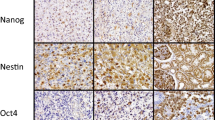Abstract
The purpose of the study was to investigate the pathological and clinical significance of the expression of nestin, a type-VI intermediate filament transiently expressed during brain development, in glioma tissue. This study was conducted in 70 patients with newly diagnosed adult supratentorial gliomas who underwent multimodality treatment in our department, including surgery. The pathological diagnosis was grade II in 6 patients, grade III in 21 patients, and grade IV in 43 patients. Two specimen sections, one from the bulk of the removed tumor and one from the border between the tumor and normal brain tissue, were subjected to immunostaining with a mouse anti-human nestin monoclonal antibody. Analyses were performed to investigate possible correlation with pathological features, the relationship between nestin expression and the continuity of tumor with the subventricular zone (SVZ), correlation with the therapeutic prognosis, etc. Nestin was expressed specifically in astrocytoma lineage cells. In oligodendroglial tumors, nestin was expressed only in less-differentiated cells and cells suggestive of the presence of astrocytoma. In astrocytic tumors, the rate and level of nestin expression increased as the degree of malignancy increased. There was no significant correlation between the expression level of nestin and the continuity of tumor with the SVZ in the contrast-enhanced imaging before surgery. In addition, no correlation with the therapeutic prognosis was observed. Nestin, a neural stem cell marker, was specifically expressed in astrocytoma lineage cells in glioma tissue. A positive correlation was observed between the degree of malignancy and the level of nestin expression. However, the level of nestin expression was not related to the tumor localization in the SVZ and was not correlated with the therapeutic prognosis.





Similar content being viewed by others
References
Dirks PB (2006) Cancer: stem cells and brain tumours. Nature 444(7120):687–688
Kappadakunnel M, Eskin A, Dong J, Nelson SF, Mischel PS, Liau LM, Ngheimphu P, Lai A, Cloughesy TF, Goldin J, Pope WB (2010) Stem cell associated gene expression in glioblastoma multiforme: relationship to survival and the subventricular zone. J Neurooncol 96(3):359–367
Li SC, Vu LT, Ho HW, Yin HZ, Keschrumrus V, Lu Q, Wang J, Zhang H, Ma Z, Stover A, Weiss JH, Schwartz PH, Loudon WG (2012) Cancer stem cells from a rare form of glioblastoma multiforme involving neurogenic ventricular wall. Cancer Cell Int 12:41
Tohyama T, Lee VM-Y, Rorke LB, Marvin M, McKay EDG, Trojanowski JQ (1992) Nestin expression in embryonic human neuroepithelium and in human neuroepithelial tumor cells. Lab Invest 66:303–313
Zhang M, Song T, Yang L, Chen R, Wu L, Yang Z, Fang J (2008) Nestin and CD133 valuable stem cell-specific markers for determining clinical outcome of glioma patients. J Exp Clin Cancer Res 27:85
Sanai N, Alvarez-Buylla A, Berger MS (2005) Neural stem cells and origin of gliomas. N Engl J Med 353(8):811–822
Singh K, Hawkins C, Clarke ID, Squire JA, Bayani J, Hide T, Henkelman RM, Cusimano MD, Dirks PB (2004) Identification of human brain tumour initiating cells. Nature 432(7015):396–401
Arai H, Ikota H, Sugawara K, Nobusawa S, Hirato J, Nakazato Y (2012) Nestin expression in brain tumors: its utility for pathological diagnosis and correlation with the prognosis of high-grade gliomas. Brain Tumor Pathol 29:160–167
Strojnik T, Rosland GV, Sakariassen PO, Kavalar R, Lah T (2007) Neural stem cell markers, nestin and musashi proteins, in the progression of human glioma: correlation of nestin with prognosis of patient survival. Surg Neurol 68:133–143
Schiffer D, Manazza A, Tamagno I (2006) Nestin expression in neuroepithelial tumors. Neurosci Lett 400:80–85
Almqvist PM, Mah R, Lendahl U, Jacobsson B, Hendson G (2002) Immunohistochemical detection of nestin in pediatric brain tumors. J Histochem Cytochem 50:147–158
Kitai R, Horita R, Sato K, Yoshida K, Arishima H, Higashino Y, Hashimoto N, Takeuchi H, Kubota T, Kikuta K (2010) Nestin expression in astrocytic tumors delineates tumor infiltration. Brain Tumor Pathol 27(1):17–21
Maderna E, Salmaggi A, Calatozzolo C, Limido L, Nestin Pollo B (2007) PDGFRbeta, CXCL12 and VEGF in glioma patients. Different profiles of (pro-angiogenic) molecule expression are related with tumor grade and may provide prognostic information. Cancer Biol Ther 6(7):1018–1024
Tohyama T, Lee VM-Y, Rorke LB, Marvin M, Mckay RDG, Trojanowski JQ (1993) Monoclonal antibodies to a rat nestin fusion protein recognize a 220-kDa polypeptide in subsets of fetal and adult human central nervous system neurons and in primitive neuroectodermal tumor cells. Am J Pathol 143:258–268
Jafri NF, Clarke JL, Weinberg V, Barani IJ, Cha S (2013) Relationship of glioblastoma multiforme to the subventricular zone is associated with survival. Neurol Oncol 15:91–96
Young GS, Macklin EA, Setayesh K, Lawson JD, Wen PY, Norden AD, Drappatz J, Kesari S (2011) Longitudinal MRI evidence for decreased survival among periventricular glioblastoma. J Neurooncol 104(1):261–269
Lim DA, Cha S, Mayo MC, Chen MH, Keles E, VandenBerg S, Berger MS (2007) Relationship of glioblastoma multiforme to neural stem cell origins predicts invasive and multifocal tumor phenotype. Neurol Oncol 9(4):424–429
Chinnaiyan P, Wang M, Rojiani AM, Tofilon PJ, Chakravarti A, Ang KK, Zhang HZ, Hammond E, Curran W Jr, Mehta MP (2008) The prognostic value of nestin expression in newly diagnosed glioblastoma. Report from the Radiation Therapy Oncology Group. Radiat Oncol 3:32
Ishiwata T, Teduka K, Yamamoto T, Kawahara K, Matsuda Y, Naito Z (2011) Neuroepithelial stem cell marker nestin regulates the migration, invasion and growth of human gliomas. Oncol Rep 26:91–99
Sugawara K, Kurihara H, Negishi M, Saito N, Nakazato Y, Sasaki T, Takeuchi T (2002) Nestin as a marker for proliferative endothelium in gliomas. Lab Invest 82(3):345–351
Acknowledgments
We are indebted to Mr. Roderick J. Turner, Assistant Professor Edward F. Barroga, and Professor J. Patrick Barron, Chairman of the Department of International Medical Communications of Tokyo Medical University, for their editorial review of the English manuscript.
Author information
Authors and Affiliations
Corresponding author
Rights and permissions
About this article
Cite this article
Tomita, T., Akimoto, J., Haraoka, J. et al. Clinicopathological significance of expression of nestin, a neural stem/progenitor cell marker, in human glioma tissue. Brain Tumor Pathol 31, 162–171 (2014). https://doi.org/10.1007/s10014-013-0169-6
Received:
Accepted:
Published:
Issue Date:
DOI: https://doi.org/10.1007/s10014-013-0169-6




